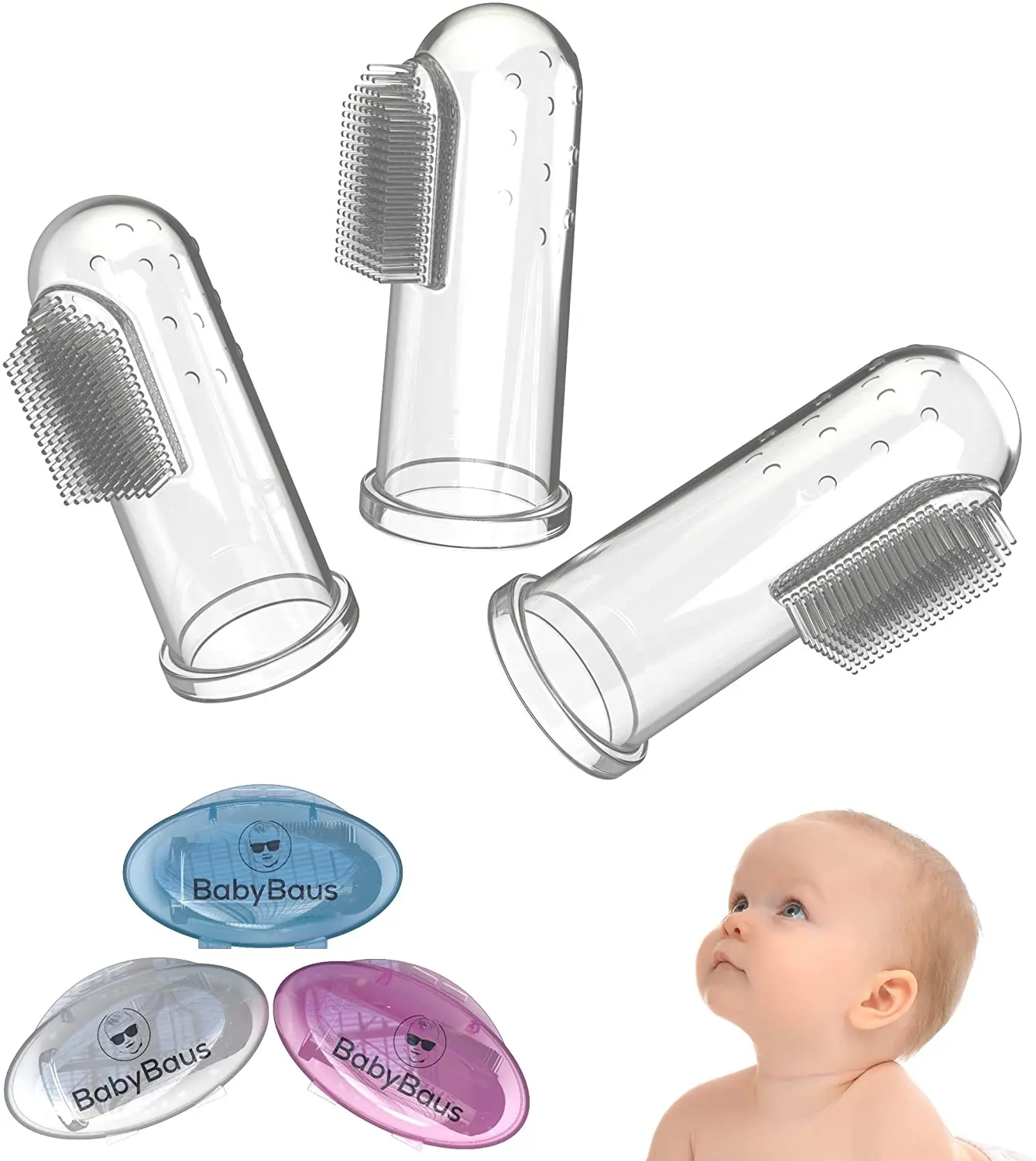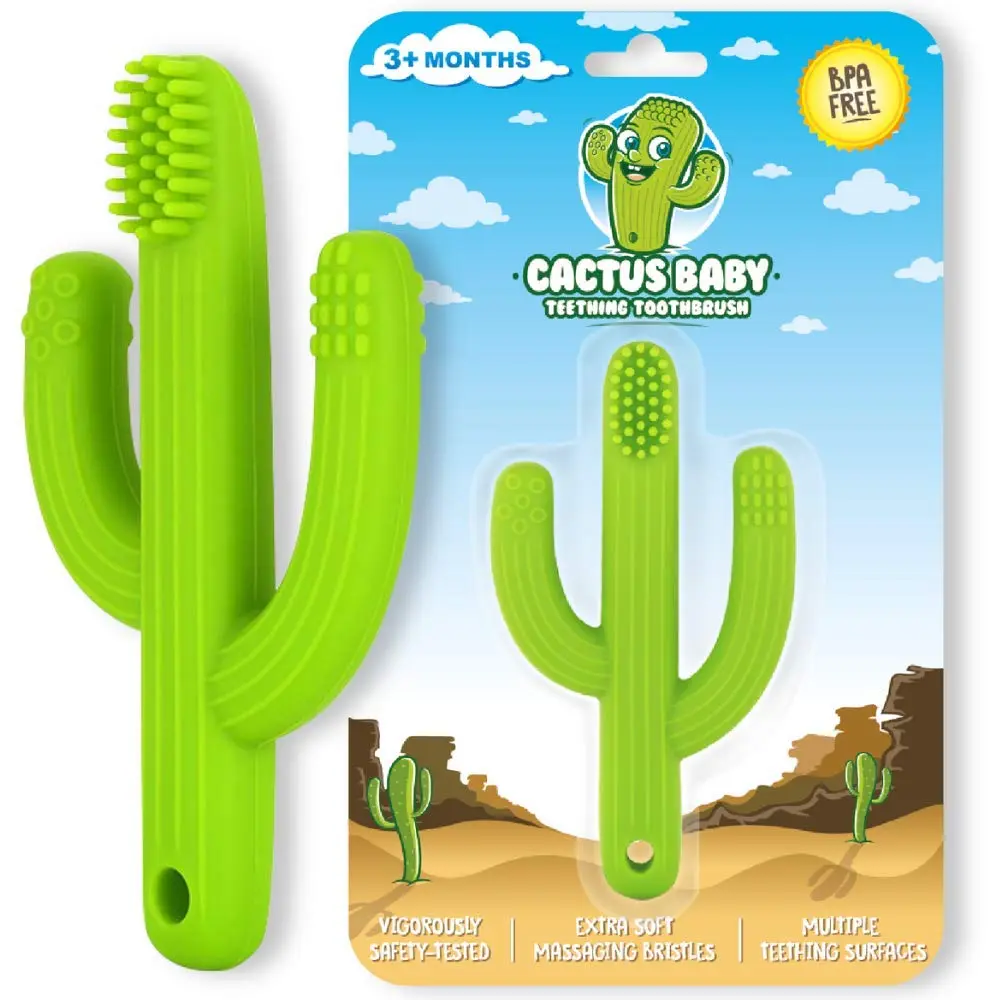- The Oral B 3000 vs 5000: Which Electric Toothbrush Is Better? - February 27, 2022
- Kid Tested and Dentist Approved: The Five Best Natural Toothpaste for Kids - February 17, 2022
- Need Orthodontic Treatment, But Not a Fan of Braces? The Five Best Braces Alternatives Available - February 7, 2022
All parents want the absolute best for their children, especially when it comes to instilling healthy habits in their lives. It’s never too early to start teaching them hygienic behaviors that will keep them healthy for a long time to come.
Keeping a healthy mouth and healthy teeth is one of the most important habits to get started early. As soon as children begin cutting teeth, it’s important to keep those brand new shiny white chompers clean and healthy. And as soon as your child can start mimicking motions, toothbrushing can be a fun activity that he or she can help with and then begin to do themselves.
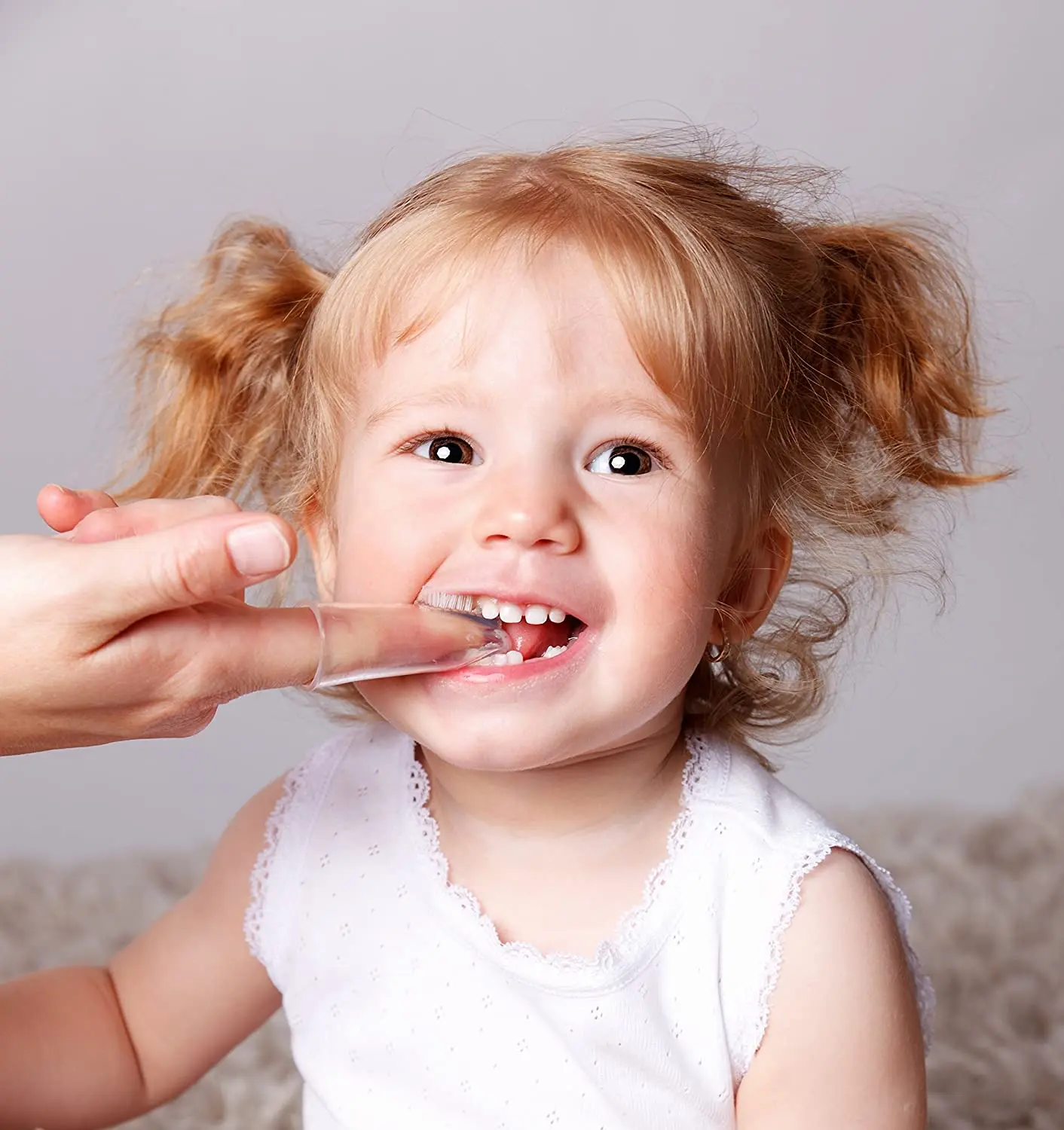
Once you’ve begun brushing your baby’s teeth, they will quickly get to the point of copying your actions and want to start trying to brush on their own. While they may still need a bit of help getting those hard-to-reach backs of their teeth, let them get used to the movements and having the brush in their mouth.
A small amount of baby toothpaste can be used, and around age two you can start teaching your child to spit out the toothpaste instead of automatically swallowing. (Just be careful with this one, toddlers don’t need any encouragement to spit!)
Why Is Brushing So Important At Such A Young Age?
Although many of us think of baby teeth as unimportant and temporary, according to the American Dental Association they’re far more vital (and have more permanent impact) than they’re given credit for!
Baby teeth are essential for a child’s health and for their adult teeth to develop correctly. Teeth help everything from eating to speaking to smiling. Baby teeth also help hold space for adult teeth to come in properly so that your child’s smile isn’t crooked or crowded. No one wants to pay for those braces!
Beginning to understand the importance of healthy habits at a young age can also help your child continue on with healthy habits as they grow older. We all know it’s more important to start good habits instead of trying to change bad habits that are already in place.
Helping your child learn to brush their teeth is an easy way to get them started on those healthy habits early and keep them going for life.
Baby’s First Toothbrush
Many parents choose to start off with a finger brush when their baby’s first teeth appear, or they will simply use a washcloth to gently wipe down their baby’s teeth and gums.
This can be done twice a day, after meals and before bed. Doctors recommend not using any kind of toothpaste until 18 months and then using low-fluoride, sugar-free toothpaste until they’re at least 6 years old.
Furthermore, they urge parents to remember that kids have brand new, sensitive palettes: while adults love the “minty clean” tingles we get after we brush, for children those strong flavors can be overpowering and cause them to get sick.
Finger brushes
These brushes are made of rubber with little nubs for gently massaging your baby’s teeth and gums. A great first brush, they are gentle, very soft, and easily cleaned. They are also available in disposable types so you don’t have any cleanup mess afterward, or trying to sanitize the brush in between uses.
Finger brushes are softer than nylon bristles on soft toothbrushes and have the added advantage of making it easy to massage and brush your baby’s gums and tongue (as much as they’ll let you!) as well as their teeth.
Choosing the right finger brush can definitely be a challenge, especially if you’re not sure where to begin. Here are several fantastic options for you to choose from, allowing you to feel confident that you’re getting the best finger brush for your little one.
BabyBaus: Baby Finger Toothbrush
This finger brush boasts that it can help make cleaning fun and comes in three fun colors, plus a handy carrying case. It’s also recommended by dentists and is made from food-grade, BPA-free, 100% silicone.
The BabyBaus is also ergonomic, which means less fussing from your baby. However, some users reported that their fingers became trapped in the small opening. Others criticized the odor of the finger brush.
Finally, the packaging was flimsy, which raised concerns of contamination.
Pros:
- Completely safe and non-toxic
- Won’t hurt sensitive gums
- Dentist recommended
- Affordable price
- Ergonomic design
Cons:
- Larger fingers can get trapped
- Poor packaging
- Can be too large for small mouths
- May have a “chemical” smell
Nuby Nananubs Banana Massaging Toothbrush
If you’re looking for a fun and adorable massaging toothbrush, then this one is just the ticket for you. Like the BabyBaus, it’s made from 100% silicone and is entirely BPA free.
The bristles are extremely soft, reducing the risk of accidentally injuring your little one. It also has handles on it, which means that your baby can hold it. Finally, it’s totally dishwasher safe, making cleaning it a total breeze.
However, some users have reported that the paint on it can be dangerous to children. Parts have also broken off, which can be a choking hazard. The poor packaging may inadvertently lead to contamination.
Pros:
- Small and soft head
- Easy to keep clean
- Free from BPA
- Can help develop motor skills
Cons:
- Small parts can break off
- Potentially dangerous paint
- Strong chemical smell
Dr. Brown’s Finger Toothbrush
This no-fuss, no-frills finger toothbrush is a great option for parents who are looking for a very basic beginner brush. It’s made out of 100% food-grade silicone, making it a safe, chemical-free option for parents.
Unlike other toothbrushes, the opening is accommodating for larger fingers, making it easy for both the parents and the baby to use. It even comes with a handy carrying case, as well.
Some parents did notice that even though it says it’s made in the USA, it was actually made in China. Others reported that it was far too small for their baby. Interestingly enough, others found it to be too large.
Pros:
- Soft and gentle design
- Safe from BPA
- Easily fits larger fingers
- Can be cleaned in boiling water
Cons:
- Misleading source country
- May not fit all mouths
- Bristles may not thoroughly clean
Our recommendation? After carefully weighing the pros and cons of each finger toothbrush, we believe that the BabyBaus: Baby Finger Toothbrush is the best option for both parents and baby.
Teether brushes
Another great choice for just starting out is an infant toothbrush that doubles as a teether. Babies love to chew on soft, rubbery things when their teeth are coming in, so turn that into automatic brushing.
Teething toothbrushes provide the best of both worlds because your baby gets a comforting way to soothe their gums while cleaning their teeth without even knowing it.
Also, this can help them associate the toothbrush with something that gives comfort instead of something that may just be strange and bothersome.
If you’re just getting started on your research on a teether brush, please don’t let your options overwhelm you! We’ve carefully handpicked the top-rated ones, helping you take the guesswork out of your decision.
Cactus Baby Teething Toys Toothbrush
If you’re wanting to help keep the baby’s mouth nice and clean, then this teether toothbrush is a fantastic option. Not only does it help improve oral hygiene, but it can also help soothe aching gums, too.
It’s made out of food-grade silicone and is entirely BPA and BPF free, helping to ensure it’s entirely safe to use.
The material is very soft, making it ideal for delicate mouths. Even better, it comes with a complete money-back guarantee. However, some users did report that it did start to rip, which could pose a choking hazard. Others did say that the bristles were too hard, and their child could not hold it with ease.
Pros:
- Made from 100% silicone
- BPA and PBF free
- Satisfaction guaranteed
- Very soft and gentle
- No chemical smell
Cons:
- Clumsy in small hands
- Small parts break off
- May not be soft enough
- Easily destroyed
Brilliant Baby’s 1st Toothbrush Teether

For brushers as young as 4 months, this toothbrush is a great way to get them into oral hygiene. The Brilliant Baby’s 1st Toothbrush has very soft and chewy food-grade silicone and a textured easily gripped handle perfect for little hands.
The unique u-shaped head sits at a right angle to the handle, an effective safety design that naturally prevents children from accidentally swallowing or otherwise potentially injuring themselves with this brush.
The product is even dishwasher safe for easier cleaning, which is an unexpected thriftiness bonus for an already affordable brush. Some parents did express concern about bristles breaking off, leading to a choking hazard. Others reported that the children did not like the brush, which meant they couldn’t use it.
Pros:
- Unique brush shape ensures safety
- Comes in a wide variety of colors
- Soft, flexible, and surprisingly durable
- Perfect for training with supervision
- Made from food-safe silicone
Cons:
- Only a “trainer” brush
- Bristles can break off
- Design isn’t user-friendly
- Doesn’t hold children’s attention
Nuby Silicone Teethe-eez Teether with Bristles
What makes this teether stand apart is its fun and unique shape. Unlike other teethers, it comes in a fish shape and has several surfaces of various textures. This can help make it easier for new teeth to breakthrough. Its shape also makes it a breeze for little hands to hang on to.
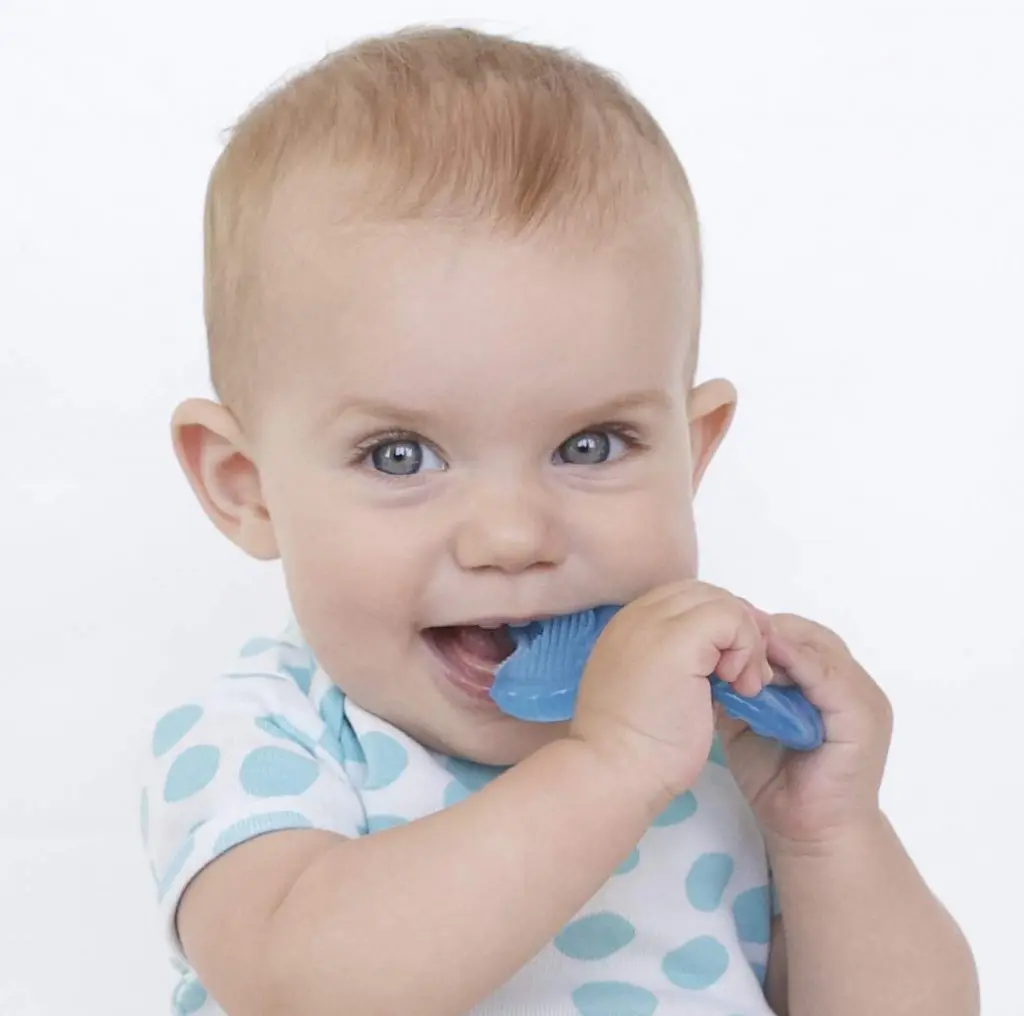
This teether is made from 100% food-safe silicone and is entirely BPA free. It can also be used on babies as young as one month old. Some users did point out that the dye leached from the product, leading to safety concerns. Others noted that it started to break apart after very little use. Finally, some babies flat-out refused to use this teether at all.
Pros:
- Easy to hold shape
- Helps teeth breakthrough
- Free from dangerous chemicals
- Very soft and gentle
- Can be used on young infants
Cons:
- May “bleed” dye
- Some babies refuse it
- Can fall apart
- Has a slight odor
Our recommendation? While each teether has its own strengths and weaknesses, thanks to its overwhelming popularity and benefits, the clear winner is the Nuby Silicone Teethe-eez Teether with Bristles.
Choosing the Right Brush Isn’t Just About Bristles
Your dentist has probably talked to you about the different types of bristles on brushes and which would be best for you: soft, medium, or hard. Of course with a child’s brush, you should always start off with the softest bristles. But even with children’s brushes, there are so many other choices to pay attention to.
A few things you may want to concentrate on include your baby’s age, how much (if at all) they are having teething issues, and how well they may be able to hold a toothbrush once they are able to grip. Some other choices include whether or not to get your child an electric toothbrush, and how much you want to stay away from brushes that aren’t ultimately good for the environment.
The biggest thing to consider when choosing a toothbrush for your child is the size of the brush head. Brush heads that are too large will not fit well in your child’s mouth and maybe uncomfortable to brush with, which might discourage them from brushing. Doctors recommend looking for a brush head that has no more than three rows of bristles, and a long handle that may make it easier to reach those shiny new molars at the back of your baby’s mouth.
If you’re looking for an eco-friendly toothbrush for your baby or toddler, there are quite a few options out there. Most of these adorable brushes are made of bamboo and are both recyclable and biodegradable. These brushes come in a range of styles and colors and are affordable for every budget.
Electric Toothbrushes for Children: To Power or Not to Power?
Many parents wouldn’t think of buying an electric toothbrush for their child, but with today’s technology, there are certainly some advantages to weigh before you completely throw out the idea.
If your child has a touch of patience or seems to lean towards an interest in electronic toys, an electric toothbrush may be just the thing to keep them brushing without having to tell them twice. Some advantages of an electric toothbrush for children include:
- May clean teeth better for children who have difficulty using a manual brush
- Features and fun styles can entice children to want to brush
- Despite being an electric toothbrush, there are very affordable models with great ratings
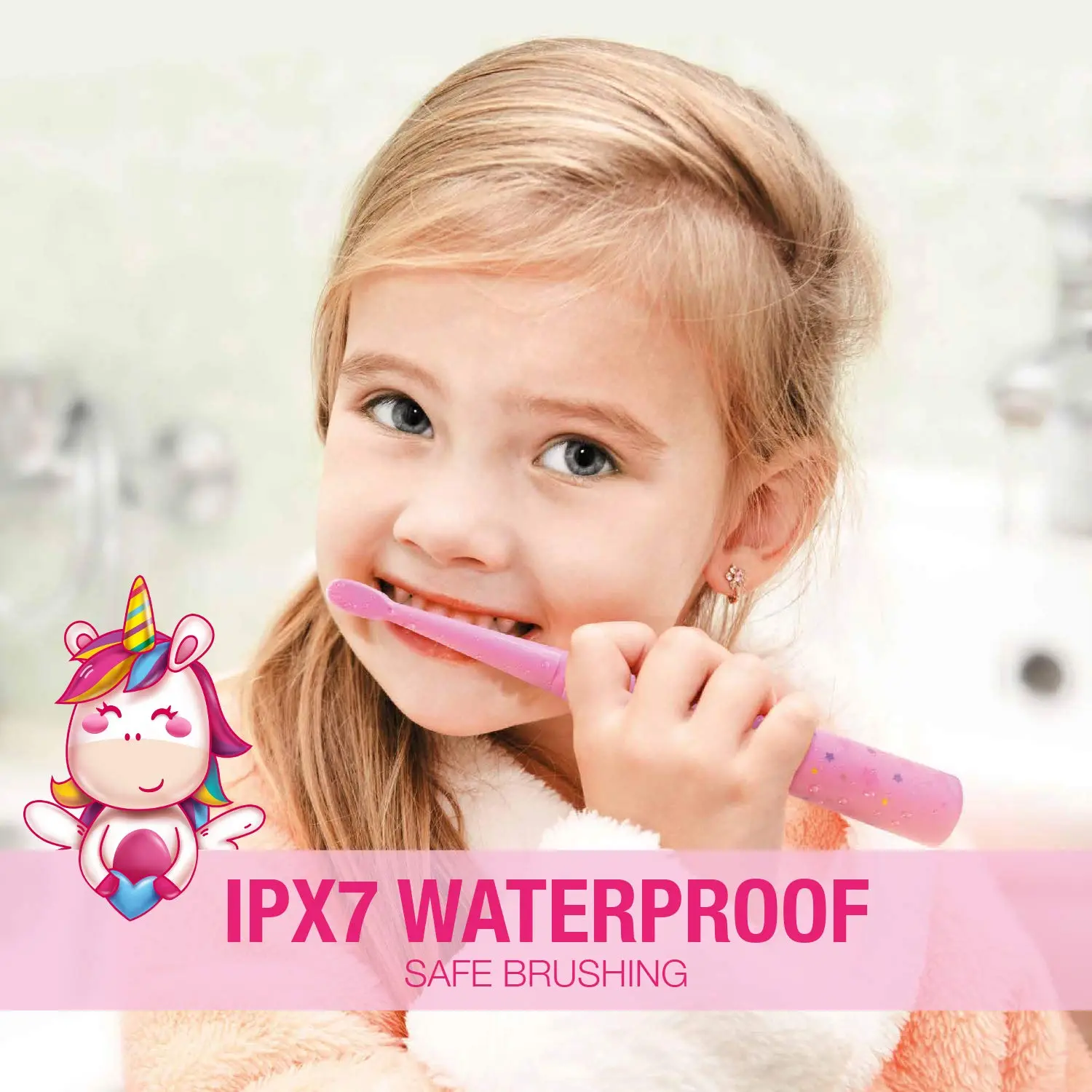
There are disadvantages to using an electric toothbrush as well. Some children may find the noise or motion of the toothbrush frightening.
Electric toothbrushes are designed to concentrate on one tooth at a time, as opposed to manual toothbrushes which can cover a few teeth at once. You will need to assure the brush stays charged, or that there are backup batteries on hand for when the brush wears out.
Baby’s First Dental Appointment
The ADA recommends making a dental appointment for your baby within six months of them cutting their first tooth, or by the time they turn a year old, whichever occurs first.
This will get your baby used to going to the dentist at an early age, as well as establish him with a dentist to keep an eye on their healthy mouth for life.
Look for reviews from other parents or recommendations from local baby-related establishments. It may also help to take your child with you to your own dentist appointments. If they see something being done to you, they may be apt to have less anxiety when the same thing is done to them and you are there beside them.
This is also a great chance to query a professional about the type of brush that you can use for baby’s teeth, or the style of brushing. If you are having difficulty brushing your child’s teeth or getting them to brush yourself, make sure you ask the doctor for tips and information on how to make this process easier for both of you and choose the best possible way to get it done.
Baby’s first appointment will take up to 45 minutes and may include an exam of teeth, jaw, gums, and mouth development. It’s very likely your child won’t be thrilled with this time, but there are ways to make it easier for both of you.
- Be positive! Your child recognizes when you are uncomfortable about something. If you are anxious at the dentist (and also are the parent in charge of taking your child to the dentist) try to calm your own anxiety and turn it into a fun experience. Remember, you’re there for their health – this is beneficial for both of you.
- Arm yourself with distractions. A pediatrician dentist’s office may have toys and books, but it still won’t hurt to take along a few of your child’s favorite things. A beloved book, stuffed animal, or toy may help to keep her distracted enough for the dentist to do what they need to do. If you allow your baby to watch cartoons even on a limited basis, this may be the time to break out the phone or iPad and pull up that video of Baby Shark.
- Make time for something fun after the visit. A simple treat (maybe some fruit to keep from undoing all that good work!) or a visit to a playground or park afterward is a great way to turn a scary first-time dentist visit into something that isn’t remembered as traumatizing for either of you. Let your child know how well they did and play with them in their favorite way. Even if the visit to the dentist wasn’t the best, this will let them move on instead of dwelling on the experience.
Is it Time for Your Child to Brush-On Their Own?
Do you think it’s time for your little one to start taking care of their own teeth? Do they try to take the toothbrush and use brushing motions themselves when you are brushing their teeth? Can they hold the toothbrush well?
If the answer to all of these is yes, then maybe the time has come for your little one to take control of this great habit on their own. Here are a few great tips for making this transition an easy one.
- Don’t expect perfection. Your child isn’t going to be brushing their teeth like a pro, possibly for a few years. Stay on hand to help them and encourage them while also lending a guiding hand. This will give them first-hand experience and at the same time make sure that their mouth hygiene is staying at its best.
- Let them choose their own tools. Let your child choose a fun new brush for this endeavor, or a new tube of toothpaste with their favorite character, or both! This lets them have some attachment to the act itself and may make it more fun for them. Just make sure they’re using the right amount of toothpaste without going overboard, especially if it’s a toothpaste with fluoride.
- Brush brush brush! If you take the time to brush your teeth at the same time your child is brushing, it can do wonders for helping them both want to do the act of brushing and to do it well. Children are all about imitating their parents — if they see you brushing for a certain amount of time and in certain ways, they will try to do the same. Then you can give them tips on how to do it better, and show them at the same time. Involvement is the best!
Give Your Baby The Best
Whether you are a first time parent or this isn’t your first rodeo, you know that oral hygiene is an important part of your child’s life and you can easily point them in the right direction.
Choosing a correct first brush for your baby can mean the difference in whether they love to brush their teeth or hate the act completely, and knowing what brush to choose throughout their childhood can make the habit easier for both of you to adopt. Remember to keep these things in mind:
- Choose a small brush head with well-contained bristles. Many complaints about baby toothbrushes are that the bristles will come out in clumps if their baby chews on the brush head. This could pose a choking hazard for your child. Make sure to read the reviews carefully before choosing your brush to ensure this won’t happen.
- Pick something that your baby will enjoy and will work well for them. This may take some experimenting. Your child may interact well with an electric toothbrush, or they may have reservations about the noise and movement. They may enjoy brushing more if the toothbrush has their favorite character or if they pick it out themselves. Make sure the brush head is small enough to fit comfortably in your baby’s mouth without choking them or being too large for their mouth size, which may make brushing uncomfortable.
- Pay attention to the long term benefits. Your baby’s dental hygiene is extremely important and teaching them the importance now will stay with them. Healthy habits can be built at a young age and will provide positive outcomes throughout your child’s life. Make brushing a fun endeavor and brush with them to teach them that not only is it important for them, but it is important for you as well.
Frequently Asked Questions
Yes, absolutely! From the moment they have their first tooth, they can start developing tooth decay. To promote oral health that’ll last their entire life, wipe or brush their teeth twice a day. Once they have two or more teeth that are touching, it is also advised to gently floss to remove buildup that the normal cleaning misses.
The moment your child starts teething, you can start using tooth wipes and gentle infant toothbrushes to keep them clean. At eighteen months, you can start using low-fluoride toothpaste, and at six years they can start brushing them with regular paste.
For children under 18 months, it is recommended to use only water. After that, you should use the same amount as adults: a pea-sized dollop. For very young children, supervise carefully to make sure they don’t swallow, as even tiny amounts can upset their stomachs and potentially cause fluorosis.
For children (and adults!) who struggle to brush properly, an electric toothbrush can be helpful to ensure every nook and cranny gets scrubbed, but nothing beats learning proper hygiene practices and sticking to them. For that reason, we recommend manually brushing until those habits are fully ingrained, and then making a decision with your pediatrician.
It is recommended to use the same toothbrush for no longer than 6 months at most, even if it still looks to be in good condition. Furthermore, if at any point the bristles are worn down, balding, or turning rough, immediately discard and replace their toothbrush.
The best way is to lead by example. Children love imitating the things they see adults do, so make sure they see you brushing your teeth, and invite them to join you. It is also a great idea to let them pick out their own age-appropriate toothbrush and toothpaste, so that they’re fully invested and look forward to brushing.
Final Thoughts
Whether a finger brush, a teether brush, an electronic brush, or a regular child-size toothbrush, this article will help you choose which brush may be right for your child to get started on their journey of the best dental hygiene.
You as a parent will be informed as to which brush will be correct for them depending on many different factors and which brush will help them build and maintain this habit throughout their life.
Your baby deserves a healthy, happy smile, and they will get it with help from you and by choosing a great toothbrush and starting early. Use this guide, and you’ll be well on your way to great oral hygiene for life!


